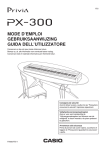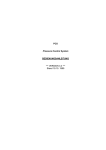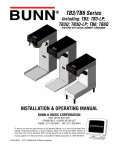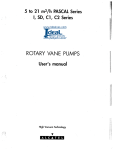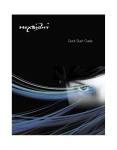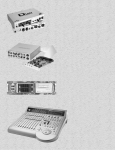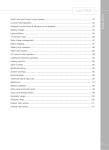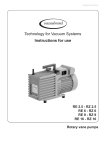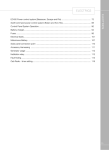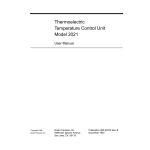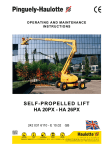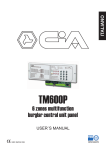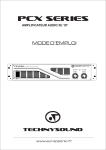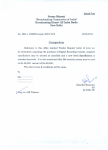Download Instruction Manual Direct Drive Vacuum Pumps
Transcript
Instruction Manual Direct Drive Vacuum Pumps Standard Models Model P100 P200 P300 P420 P765 P1420 Precision Catalog No. 51220221 51220225 51220229 51220233 51220237 51220240 Corrosion Resistant PC100 PC200 PC300 PC420 PC765 51220223 51220227 51220231 51220235 51220238 Explosion Proof PX100 PX200 PX300 PX420 PX765 PX1420 51220222 51220226 51220230 51220234 51220239 51220241 Corrosion Resistant/Explosion Proof PCX 100 51220224 PCX200 51220228 PCX300 51220232 PCX420 51220236 Precision 170 Marcel Drive Winchester, VA 22602 USA Phone: 540-869-8623 Toll Free: 800-621-8820 FAX: 540-869-8626 Manual P/N 83000027 Rev. B Dated 15NOV01 NOTICE THE MATERIAL IN THIS MANUAL IS FOR INFORMATION PURPOSES ONLY. THE CONTENTS AND THE PRODUCT IT DESCRIBES ARE SUBJECT TO CHANGE WITHOUT NOTICE. PRECISION MAKES NO REPRESENTATIONS OR WARRANTIES WITH RESPECT TO THIS MANUAL. IN NO EVENT SHALL PRECISION BE LIABLE FOR ANY DAMAGES, DIRECT OR INCIDENTAL, ARISING OUT OF OR RELATED TO THE USE OF THIS MANUAL. For repair information or replacement parts assistance from the manufacturer, call Customer Service using our toll free telephone number. 800-621-8820 (FAX) 540-869-0130 ii REVISION STATUS INDEX DATE A 6/00 B 11/01 AMENDED PAGES NOTES 40 Add P765 and P1420 references Add Spare parts and warranty info Corrected P100-420 motor part no. iii Contents The Precision P Series Vacuum Pumps Introduction and Unpacking.................................................................................................. 1 Presentation of the product range ......................................................................................... 2 Operating principle of a rotary vane pump ...............................................................................................................4 Technical characteristics ......................................................................................................7 Pump dimensions.................................................................................................................8 Installation and connections Safety instructions ..............................................................................................................10 Filling with oil ..................................................................................................................... 12 Mechanical connections .....................................................................................................13 Electrical connections ........................................................................................................ 15 Motor protection .................................................................................................................. 16 Operation Precautions ........................................................................................................................ 18 Operating temperature ........................................................................................................ 18 Before starting up lhe pump................................................................................................ 18 Start-up ............................................................................................................................... 19 Operation of gas ballast ...................................................................................................... 20 Particular uses ................................................................................................................... 22 Oxygen pumping ................................................................................................................23 High pressure pumping and cycling ................................................................................... 24 Maintenance Precautions ........................................................................................................................ 25 Troubleshooting and corrective actions .............................................................................. 26 Maintenance frequency ...................................................................................................... 29 Draining the oil ................................................................................................................... 29 Flushing the pump ..............................................................................................................30 Change of type of oil........................................................................................................... 30 Replacement of front shaft seal .......................................................................................... 31 Disassembling the pump ....................................................................................................32 Cleaning components ........................................................................................................ 35 Replacement of all shaft seals............................................................................................ 36 Reassembling the pump ....................................................................................................37 Spare parts and accessories .............................................................................................. 39 Warranty ............................................................................................................................41 iv Introduction Unpacking and Damage Your satisfaction and safety are important to PRECISION and a complete understanding of this unit is necessary to attain these objectives. This product was carefully packed and thoroughly inspected before leaving our factory. Save all packing material if apparatus is received damaged. As the ultimate user of this apparatus, you have the responsibility to understand its proper function and operational characteristics. This instruction manual should be thoroughly read and all operators given adequate training before attempting to place this unit in service. Awareness of the stated cautions and warnings, and compliance with recommended operating parameters — together with maintenance requirements — are important for safe and satisfactory operation. The unit should be used for its intended application; alterations or modifications will void the warranty. Responsibility for safe delivery was assumed by the carrier upon acceptance of the shipment; therefore, claims for loss or damage sustained in transit must be made upon the carrier by the recipient as follows: Visible Loss or Damage: Note any external evidence of loss or damage on the freight bill or express receipt, and have it signed by the carrier's agent. Failure to adequately describe such external evidence of loss or damage may result in the carrier's refusing to honor your claim. The form required to file such claim will be supplied by the carrier. WARNING AS A ROUTINE LABORATORY PRECAUTION, ALWAYS WEAR SAFETY GLASSES WHEN WORKING WITH THIS APPARATUS. This product is not intended, nor can it be used, as a sterile or patient connected device. In addition, this apparatus is not designed for use in Class I, II, or III locations as defined by the National Electrical Code. Concealed Loss or Damage: Concealed loss or damage is any loss or damage which does not become apparent until the merchandise has been unpacked and inspected. Should either occur, make a written request for inspection by carrier's agent within 15 days of the delivery date; then file a claim with the carrier. If you follow the above instructions carefully, PRECISION will guarantee our full support of your claim to be compensated for loss or damage in transit. DO NOT — for any reason — return this unit to PRECISION without first obtaining return authorization. In any correspondence with PRECISION please supply the nameplate data, including catalog number and serial number. 1 Presentation of the product range A wide range Specific solutions adapted to various applications Precision oil seal rotary vane pumps are used in all vacuum technology applications They can be used on their own to achieve a maximum vacuum of 103 Torr (103 mbar), or in pumping assemblies, e.g. at the exhaust of a diffusion pump or turbo-molecular pump. Standard pumps These pumps are used in all noncorrosive applications. Manufacture of light bulbs, production of 1V tubes, manufacture of electronic tubes, metallurgy, centrifuges, vacuum ovens, etc. Corrosion resistant Pumps suited to the pumping of corrosive gases. R&D, laboratories, freeze-drying, pumping of solvents, extractions, etc. Explosion proof Pumps with sealed motors. For all applications in class I-II, group D, E, F and G environments. Explosion proof / Corrosion resistant For use in applications in class I - II, group D, E, F and G environments where corrosive gasses will be produced. 2 Precision P series Pumps Features Four 5 to 21 m3/h pump models with the following main characteristics: • A direct drive motor makes the pumps very compact. • An electrically insulated foldaway handle is used for easy carrying. • An anti-suck-back system ensures the tightness of the pump during accidental or voluntary shutdowns. • A gas ballast enables the pumping of condensable vapors . • The universal three-phase or single-phase motor can be disassembled independently of the rest of the pump, without the need to drain the oil case. • On the oil case, a vertical sight glass can be used to inspect the oil level easily when filling the tank and during the operation of the pump. 1. 2. 3. 4. 5. 6. Oil case Gas ballast control Base Oil level sight glass Filling plugs Draining plug 7. 8. 9. 10. 11. 12. Frame Inlet end fitting Exhaust end fitting Foldaway handle Electric motor IEC electric socket The inlet and exhaust end fittings are PNEUROP ISO-KF standardized. They are fitted vertically on the pump at delivery but can be positioned on the horizontal openings if required by operating conditions. They can also be used to connect many of our accessories. The main replacement parts are interchangeable: This enables easier disassembly-assembly operations and replacement without changing the pump’s performance. Various accessories can be used to adapt the pump to meet the requirements of your application. These accessories can be mounted to the top or the side inlet and exhaust ports. The moulded aluminium pump frame supports the pumping module and the motor. All the parts of the pumping module in contact with gases are free of zinc, copper and cadmium. The other construction materials include cast iron, aluminium alloy, stainless steel, fluorocarbons (FPM), nitryl (NBR) and chemically resistant polymers. 3 Operating principle of the rotary vane pump Rotary Each stage of the PRECISION P series pumps consists of: vane pump - A hollow cylindrical stator with inlet and exhaust valves. - A rotor mounted eccentrically inside the stator for pumping. - Two vanes sliding in the rotor, forced against the stator by centrifugal force and springs. The pumping cycle is given below: As the vane passes in front of the inlet orifice, an increasing space is formed into which the gas from the chamber to be evacuated expands. When the second vane passes, the space is closed. Inlet Transfer The gas trapped in the space between the two vanes is transferred to the exhaust orifice as the rotor rotates. Compression The space communicates with the exhaust, which is fitted with a valve: the gas is compressed until the safety valve is opened. Exhaust The gas is expelled into the oil casing when the pressure is sufficient to open the valve. Application Single stage rotary vane pumps are the best choice for continuous pressures above 1.0 Torr (1,3 mbar), as well as applications where large amounts of condensable gases are present. 4 Two-stage To improve the backing pressure and flow rate at low pressure, two rotary vane pump stages are connected in series. The second is similar to the first both structurally and operationally. The gases pulled in by the first (low pressure) stage are transferred to the second (high pressure) stage and discharged through the high pressure (HP) valve. In. Exh. Low pressure stage Application High pressure stage Two stage rotary vane pumps are the best choice for application requiring an ultimate vacuum as low as 10.3 Torr (1.33 x 10.3 mbar). NOTE: WHEN OPERATING A TWO STAGE VANE PUMP CONTINUOUSLY, GREATER THAN HALF AN HOUR, ABOVE 10 TORR, THE UNIT SHOULD BE EQUIPPED WITH AN OIL MIST ELIMINATOR AND OIL RETURN SYSTEM, OR A SINGLE STAGE PUMP SHOULD BE USED. 5 Oil Its function Oil has several important functions in the pump: -Itlubricatesmechanicalcomponents(bearings,seals,rotor,vanes,etc.). - It makes moving parts relatively tight by limiting internal leakage. -Itcarriesawaytheheatproducedbythecompressedgases. Choosing the right oil Not all oils produce the same ultimate pressure in a given pump. Ultimate pressure depends on the saturated vapor pressure of the oil, its viscosity and its ability to dissolve gases. Good pumping conditions are related to the type of oil used. The choice depends on: - Expected pump performance. - Chemical aggression and corrosion of pumped gases. - Accessories used. - Desired maintenance intervals and total operating cost. PRECISION has selected various types of oil for its pumps. Lubrication and antinoise device The pump is equipped with a lubrication system which regulates the oil flow rate required in the vacuum pump. In addition this system also ensures the gassing of the lubrication oil and therefore the low noise level of the pump. Gas ballast When condensable vapors are being pumped, gas is compressed beyond its saturated vapor pressure in the “compression” phase and can condense, impairing pump performance. The gas ballast can be used to inject a certain quantity of air (neutral or dry gas) into the last stage of the pump during the “compression” phase so that the partial pressure of the pumped gas is less than its saturated vapor pressure at the temperature of the pump. Condensation is therefore impossible if this limit is not reached. The maximum admissible vapor pressure is obtained at pump inlet for this value. At the end of “compression”, the pressure in the exhaust chamber is greater than atmospheric pressure. An anti-suck-back device (valve + spring) prevents the gases and oil from being drawn back into the inlet. The saturated vapor pressure of a body is higher when the system is hot than when it is cold; therefore, the pump must reach operating temperature before pumping condensable vapors. -Using the gas ballast increases the ultimate pressure of the pump as well as the temperature. - The gas ballast control, located at the front of the oil case cannot be used to set the gas injection flow rate. - When the gas ballast control is open, the pump is not tight when stopped. To guarantee this tightness, install an automatic gas ballast. 6 Technical Characteristics Standard Series: Characteristics Unit Frequency P100/PX100 P200/PX200 P300/PX300 P420/PX420 P765/PX765 P1420/PX1420 Hz 50 60 Number of Stages 50 60 2 50 60 2 50 60 2 50 2 60 50 60 2 2 Rotation speed rpm 1500 1800 Nominal flow rate m3/h cfm 5.4 6.5 3.8 9.7 11.6 6.8 15 18 10.6 20.7 24.8 14.6 30 36 23.3 60 72 42.4 Flow rate Pneurop method m3/h cfm 4.8 5.7 3.35 8.5 10.2 6 12.5 15 8.8 15.5 20 11.8 27 31.9 18.8 55 64.6 38 Partial ultimate pressure * with Alcatel 120 oil Torr/mbar /Pa 7.5x10-5 / 1x10-4 1x10-2 1.5x10-4/2x12.2x10-4/3x10-4 0-4 3x10-3 -2 2x10 Ultimate pressure with gas ballast closed Torr/mbar Pa 1.5x10-3 / 2x10-3 2x10-1 2.2x10-3/ 3x10-3 3x10-1 Ultimate pressure with gas ballast open Torr/mbar Pa 7.5x10-3 / 10-2 1 1.5x10-3/ 2x10-2 2 Oil Capacity Weight (pump + motor) Maximum water vapor pumping capacity (Ballast flowrate 1.1 m 3 / h) l 0.83 0.95 0.95 0.98 3.6 7.0 kg(lbs) 25 (55)** 26 (57.2)** 27 (59.4)** 28 (61.6)** 61 (134) 93 (205) 7 700 30 3000 25 2500 700 1200 mbar Pa Water vapor pumping capacity Inlet and exhaust end fittings 1500 1800 1500 1800 1500 1800 1500 1800 1500 1800 35 25 20 15 12 10 3500 2500 2000 1500 1200 1000 g/h 120 110 125 ISO-KF 100 110 100 90 90 DN 25 DN 40 * Partial pressure measured according to Pneurop 6602 specificatin. It may vary if other oils are used. ** These values are for pumps equipped with universal single phase motors. Note: The pressure measurements were made with a capacitive diaphragm pressure gauge measuring a total pressure in the absence of a cold trap. Measurements using a Pirani type gauge can give different pressure values. Corrosive applications: Characteristics Frequency Unit Hz PC100 PCX100 PC200 PCX200 PC300 PCX300 PC420 PCX420 50 50 50 50 60 Number of Stages 60 2 60 2 60 2 PC765 50 60 2 2 Rotation speed rpm 1500 1800 Nominal flow rate m3/h cfm 5.4 6.5 3.8 9.7 11.6 6.8 15 18 10.6 20.7 24.8 14.6 30 36 23.3 Flow rate Pneurop method m3/h cfm 4.8 5.7 3.35 8.5 10.2 6 12.5 15 8.8 15.5 20 11.8 27 31.9 18.8 Partial ultimate pressure * with Alcatel 120 oil Torr/mbar /Pa 7.5x10-5 / 1x10-4 1x10-2 1.5x10-4/2x10-4 2x10-2 Ultimate pressure with gas ballast closed Torr/mbar Pa 1.5x10-3 / 2x10-3 2x10-1 2.2x10-3/ 3x10-3 3x10-1 Ultimate pressure with gas ballast open Torr/mbar Pa 7.5x10-3 / 10-2 1 1.5x10-3/ 2x10-2 2 Oil Capacity 1500 1800 1500 1800 1500 1800 1500 1800 l 0.83 0.95 0.95 0.98 3.6 Weight (pump + motor) kg(lbs) 25 (55)** 26 (57.2)** 27 (59.4)** 28 (61.6)** 61 (134) Maximum water vapor pumping capacity (Ballast flowrate 1.1 m 3 / h) mbar Pa 7 700 30 3000 Water vapor pumping capacity Inlet and exhaust end fittings g/h 35 25 20 15 12 10 3500 2500 2000 1500 1200 1000 120 110 ISO-KF 125 100 110 100 90 90 DN 25 * Partial pressure measured according to Pneurop 6602 specificatin. It may vary if other oils are used. ** These values are for pumps equipped with universal single phase motors. 7 700 DN 40 Pump Dimensions Pump Styles P100 - P420 Dim. Pump Type (mm) P 100 P 200 P 300 P 420 A 228 245 270 291 B 143 200 225 246 8 Pump Styles P-765 and P-1420 Dimensional drawings P-765 / PX765 - P-1420 / PX1420 b D 336/ 385 H exhaust a Gas ballast 362 to 385 410 to 422 288/ 342 Fill plug 11/4 G 323/371 Inlet 103 118 53 42 56 45 NW 40 L 164/ 186 455/ 529 31/ 29 12 12 Drain plug 3/8 G 206/ 229 140/ 190 375/ 459 437/ 521 213/ 264 Types 33/63 PC-765 Fill plug 11/4 G Inert gas inlet 1/8 NPT Oil casing purge 1/8 NPT D Ø 76 H Exhaust NW 40 b Oil filter 53 42 56 45 Gas ballast 389 to 398 438 to 447 Inlet a 323/ 371 L 103 118 164/ 186 452/ 526 288/ 342 336/ 385 91 91 31/ 29 12 12 Drain plug 3/8 G 206/ 229 375/ 459 437/ 521 140/ 190 213/264 Types 33/63 Dimensions Dimensions P/N Motor type L mm D mm H mm a mm b mm P-765 PC-765 UL/CSA CE 240 185 142 265 87 P/N Motor type P-1420 UL/CSA PC-1420 CE 9 L mm D mm H mm a mm b mm 285 195 149 25 87 Safety instructions concerning the installation and operation of pumping systems Before switching on the equipment, the user must read all of the start-up and operation sections of this manual and observe the safety instructions listed in the booklet of declarations of compliance supplied with the unit. Unpacking When you receive the equipment, unpack it carefully. Do not discard the packaging until you have ensured that the pump has not been damaged during transport. Otherwise, take the necessary measures with the transporting company and, if necessary, notify PRECISION. For all handling, only use the devices provided for this purpose (lifting rings, handle, etc.). The pump is not supplied filled with oil. The oil is contained in separate bottles. Similarly, it is recommended to drain the pump before re-dispatching the equipment. Storage • If the pump is to be stored, we guarantee the reliability of our equipment without particular storage precautions for up to 3 months (ambient temperature between 41°F and 149°F or 5 and 65°C). • For storage periods of over 3 months, we recommend to fill the pump with oil during storage. For this, fill the pump and run it at ultimate vacuum (inlet orifice blocked) for approximately 1 hour in order to lubricate all the parts of the functional block (see page 18). Then, stop the pump and store it with the inlet and exhaust orifices sealed: clamping ring, centering ring, plug, etc. The shaft should be rotated by starting the pump every six months following this storage procedure. • After 6 months storage without oil, factors such as temperature, degree of humidity, salt air, etc. may cause the deterioration of the pump components, particularly the hardening of O-rings and the “sticking” of lip seals on shafts and the gumming of oil In this state, a pump may have operation problems, particularly oil leaks Before the next start-up, the pump must be disassembled (see page 31), and all the seals changed. Note 1: The seal kits must be stored with caution. Keep them away from heat and light (sunlight and ultraviolet light) in order to prevent the elastomers from hardening (AFNOR standard FD T 46.022). 10 Installation and • The machines must be connected to an electrical installation in start-up compliance with decree 88-1056 dated 14th November 1988, as well as any local electrical codes that apply. • It is important to isolate the machine from the power source before any maintenance is done on the equipment. • When switching off the power of equipment containing capacitors loaded with over 60 VDC or 25 VAC, take precautions when accessing the connector pins (single phase motors, equipment with mains filter, frequency converter, monitor, etc.). • Vane roughing pumps use lubricants. It is recommended to request information from the manufacturer on the safety data sheets concerning the product used. • Our pumps are tested in the factory with a high quality distilled oil. PRECISION recommends the use of PRECISION B+ oil with all of their vacuum pumps. If changing the type of oil, refer to the chapter concerned for the procedure and the type of lubricant required. • Our pumps are designed to prevent any thermal risk for user safety. However, specific operating conditions may generate temperatures which may justify particular attention on the part of the user (outer surfaces > 70°C). 11 Filling with oil PRECISION two-stage pumps for corrosive applications are tested in the factory with a high quality distilled oil. At delivery, there is some oil remaining in the functional block. Our pumps are tested in the factory with a high quality distilled oil. PRECISION recommends the use of PRECISION B+ oil with all of their vacuum pumps. To change the type of oil, refer to the Maintenance Chapter, “replacement of type of oil” section. In all cases, follow the recommendations of the pump specifier for the choice of oil to be used. If necessary, carry out the special preparation procedure for the pump, then, remove the filling cap and fill with oil until the oil reaches the highest mark on the sight glass. This operation must be performed with the pump switched off. The second filling orifice is used if an external oil filtration device is connected. Checking the oil level To use the pump in optimum conditions, the oil level must be observed and checked regularly. This level is checked with the pump switched off, hot and on a horizontal plane. Oil level sight glass for PC Series Pumps Oil level sight glass for P Series Pumps Note: Optimum pump performance and service life are obtained when the oil level is between the maximum level and the minimum level. 12 Mechanical connections For a given application, pump performance, vacuum characteristics, temperature and reliability depend on the following: - assembly conditions, accessory filters. - the oil used. - mechanical connections: pipes, etc. - maintenance frequency and quality. For the assembly of the vacuum circuit, provide the accessories required for maintenance: valves, purges, etc. Mounting on a frame The pump can be mounted on a frame using the 4 attachment holes on the base and the shock mounts supplied. Note: Special shock mounts, effective against the pump’s own vibrations, can also be used but they do not ensure correct attachment during the transfer of equipment. In this case, the pump should be clamped onto its support. Ventilation The pump and the motor are each equipped with a ventilation system. During pump installation, the pump should be placed in ventilated place. Provide a minimum gap of 25 mm around the pump. The vents on the pump and the motor should be checked regularly to ensure that they are not blocked. PRECISION P series pumps are designed for operation at an ambient temperature between 53°F and 113°F (1 2 and 45°C). Inlet and exhaust fitting Remove the protective caps on the inlet and exhaust orifices; these components prevent foreign bodies from entering the pump during transport and storage. It is dangerous to leave them on the pump during operation. The pump inlet and exhaust orifices are equipped with DN 25 ISOKF end fittings which can be used to fit various line components made of stainless steel, plastic, etc.. Exhaust Inlet Make sure that all the It is recommended to components or the connect the pump exhaust chamber connected to to a smoke / mist the pump inlet withstand a eliminator. negative pressure of 1 bar relative • If the pump exhaust orifice is to atmospheric pressure. connected to an extraction duct or an oil mist eliminator, the exhaust stop valve fitted in the pump exhaust orifice must be removed. • At the pump exhaust, the evacuation circuit must be such that the resulting excess pressure Also make sure that in the oil case is as low as the maximum excess possible: for correct pump pressure does not exceed operation the max. exhaust 1 bar relative to atmospheric pressure recommended should be 1.125 Tor (1.5 bar) absolute pressure (for security). pressure. 13 Changing position of inlet Depending on the types of accessories used and the pumping and exhaust fittings conditions, these orifices can be fitted vertically on the pump or horizontally as shown on the diagram below. Note: The pump is supplied in configuration A. Disassembling the fittings Unfasten the attachment screw from the end fitting to be removed. 4 30 Unfasten the end fitting and remove it from its housing along with the O-ring In the case of the inlet end fitting, also remove the inlet filter. Horizontal reassembly Remove the attachment screw from the lateral cap and using a wide screwdriver, remove the cap. • Position the end fitting in the corresponding lateral orifice taking care to fit the O-ring. Attach the end fitting with the screw. In the case of the inlet end fitting, fit the filter at the bottom of the orifice. • Close unused orifices with plugs and fasten the screws. 14 Electrical connections The machines must be connected to an electrical installation in compliance with the decree 88-056 dated 14 November 1988, as well as any local electrical codes that apply. • Our products are designed to meet current EEC regulations. Any modification on the part of the user are liable to cause noncompliance with regulations or even affect the EMC (Electromagnetic compatibility) performance and safety of the product. Precision cannot be held responsible for consequences resulting from such an intervention. • Before any maintenance intervention on a product performed by a maintenance operator who has not been trained on safety regulations (EMC. electrical safety, chemical pollution, etc.) isolate the product from its various energy sources (electricity, compressed air, etc.). • As a general rule, it is recommended to protect the motor for 120% of its nominal current (see page 15). • Check that the electrical wiring and the voltage selector position of the motor correspond to the line voltage, before starting up the pump. • Ensure that the electrical installation conforms with your local safety requirements. It must include the appropriate fuse and reliable earth ground. Three-phase version Electrical motor is in accordance with major international standards (UL, CSA, CE) and offers two voltage ranges: • Low voltage: 170 V to 254 V 50Hz 170 V to 300 V 60Hz, • High voltage: 342 V to 460V 50Hz-342V to 520V 60Hz. All three phase motors (protection level IP 43. TEFC type) must be protected by a customer supplied starter consisting of a suitably rated contactor and thermal overload. Furthermore, they are equipped with a dry contact (NC) thermal protection which is available in the terminal box. Wire the motor according to the line voltage. The connections to be made are shown on a diagram inside the terminal box or on its lid. Check the direction of rotation of the motor (direction of arrow located on the motor cover). For this: • Remove the protective caps on the inlet and exhaust orifices. • Vent the pump to atmospheric pressure. • Switch on the pump for 2 to 3 seconds, with your hand on the inlet orifice. If suction is felt, the wiring is correct. Otherwise, invert 2 consecutive phases. The earth terminal must be connected correctly. Single-phase version Electrical motor is in accordance with major international standards (UL, CSA, CE) and offers two voltage ranges: • Low voltage: 90 V to 132 V 50/60Hz. • High voltage: 180 V to 254 V 50/60Hz. Note: single-phase motors (protection level IP 43 - TEFC type) have a thermal circuit interrupter with an automatic starting device: when the internal motor temperature reaches a value over the preset limit value, the motor stops. However, when the motor is cooled, it will start up again automatically. Before connecting to the mains, check the position of the voltage selector: High Voltage (HV) or Low Voltage (LV) (see table page 16) The plug is equipped with a ground pin which must be connected. The motor rotation direction is set at the factory. 15 External motor protection, electrical protection Motor characteristics, The information below is given as a recommendation. The user must comply with the electrical standards or connection, protection recommendations (IEC, VDE, UL, CSA, etc.) applicable in the country in which the pump is used. The use of electrical protection for the pump motor makes it possible to protect: • The motor: in the event of excess voltage or rotor blocking, the resulting excess current may destroy the coil and possibly the start-up system (for a single-phase motor). • The pump: in the event of a lubrication fault (contaminated oil, presence of particles), increased resistance will draw excessive motor current. Differential thermal circuit-breakers should be used, in which the mechanism contains an instantaneous disconnection controlled by a bimetal blade. Never protect a three-phase motor with fuses not equipped with a differential system: if three phase motors are powered on 2 phases without a differential system, the motor could burn. single-phase motor: The table on the following page gives the characteristics at startup (for temperatures ≥ 12°C) and in permanent operation. In this table, you will find, for each pump, a standard fuse or motorassociated value. three-phase motor: The table on the following page gives, for each pump, the electrical characteristics in permanent operation and the proposed circuit breaker. Single-phase motors Single-phase motors have a thermal circuit switch with automatic Specific internal protection starting device (CSA standard): when the internal motor temperature reaches a value over the preset limit value, the motor stops. However, when the motor is cooled, it will start-up again automatically. Voltage range change The voltage range can be read beside the motor switch: the dual frequency single-phase motor can be configured for low voltage (LV) or high voltage (HV). To change this type of connection, proceed as follows: • make sure that the motor is not switched on, and the power cord is removed, • unfasten the 4 attachment screws on the motor upper cover and remove it, • remove the voltage selector cover marked with the voltage, press on the voltage selector (position II). • invert the position of the voltage selector cover in order to show the other voltage at the outside of the motor cover: ‘HV’ for high voltages, or “LV’ for low voltages. Check to be sure that the voltage selector has fully latched the rocket switch when the voltage selector cover is replaced. • install the upper cover and refasten the 4 screws. • secure the upper cover as follows: • Center it on the front motor flange, • Install the connector between the relay and condenser, • Close the upper cover, • Install and tighten the 4 screws, starting installing the screws on the pump handle side first. 16 Three-phase motors Electrical connections The pumps are equipped with 9 wire terminal box motors, the wiring diagram of the terminals is given as a rough guide only. In the event of doubt, only the plate in the terminal box should be used as a reference. Terminal box (9 wires) Summary tables of various The characteristics and ratings of fuses and circuit breaker of motors standard PRECISION pump types of motors associated with types 3 motors, 5 to 21 m /h, single-phase or three-phase. Single-phase motor Current at Ultimate Pressure (A) Voltage/Frequency *Start-up current (A) Proposed Fuse protection (A) 50 Hz 60 Hz 50 Hz 60 Hz 100V 50/60 Hz 115V 60 Hz 5.0 3.5 4.0 30.0 34.0 35.0 20/20 20 8/6 6 200V 50/60 Hz 2.5 2.0 14.0 19.0 10/16 4/4 20.0 16 4 10 4 2.0 220V 60 Hz 230V 50 Hz 3.5 8.0 Standard Type aM** * Temperature = 12°C ** aM: Motor-associated type fuse Three-phase motor *Start-up current (A) Voltage/Frequency Proposed Circuit Breaker protection (A) 50 Hz 60 Hz Standard Type aM** 200V 50/60 Hz 3.1 2.8 4 3.5 220V 50/60 Hz 240V 50 Hz 3.5 4.0 3.1 4.5 5 4 Low voltage 3.7 280V 60 Hz 4.5 High votlage 380V 50 Hz 1.5 2 415V 50 Hz 1.6 2 480V 60 Hz 1.6 * Temperature = 12°C 17 2 Operation Preliminary precautions • The performance and operating safely of this product can only be guaranteed if it is operated according to normal conditions of use. • The vacuum pump is also a compressor: incorrect operation may be dangerous. Study the user manual before starting up the pump. • The pumps are designed to prevent any thermal risk for user safely. However, specific operating conditions may generate temperatures which may justify particular attention on the part of the user > 70°C). • Product tightness is guaranteed for normal operating conditions when the product leaves the factory. It is the user’s responsibility to maintain the level of tightness particularly when pumping dangerous products (on PC or PCX series pumps). Be sure to fill the pump with oil (see page 11) Operating • At start-up, before switching on the motor, check that the oil bath temperature temperature is greater than 53°F (12°C). • The ambient operating temperature for the pump must be between 53°F (12°C) and 113°F (45°C). • Under these conditions, the stabilized pump temperature (at the front of the oil case) will be between 140°F and 158°F (60 and 70°C) (depending on operating conditions). Special case - Synthetic oils Synthetic oils are much more viscous when cold than mineral oils. Do not start up the pump at ambient temperatures below 59°F (15°C). For the same reason and to facilitate lubrication of the pump, pour a few drops of oil (I to 2 cm3) through the inlet orifice before starting. Before starting the pump Check that the exhaust orifice is not blocked. In certain cases, when the pump is ,started up in cold ambient conditions, or with slightly contaminated oil, the current after startup may remain high until the oil in the pump is heated up. These conditions are sufficient for the internal thermal protection to be activated, making start-up impossible (see pages 15 & 16). 18 Start-up • When using a three phase motor, check the direction of rotation of the motor (see electrical connections start-up chap. page 14) • Check the oil level (See page 11). • Start-up the pump. • Allow the pump to run for one hour with the inlet blocked at ultimate vacuum: During this operation, make sure that the oil circuit is operating. Remove one of the oil fill plugs to listen to the pump. At start-up, the oil enters the lubrication circuit of the vacuum pump. As a result, noises will be heard (first irregularly, then regularly) which will reduce as the oil heats up. These noises will no longer be heard when the fill plug has been replaced. Under normal temperature conditions, the oil circuit should start less than 1 minute after start-up (this time may vary with the type of oil and its degree of contamination). • Using the gas ballast: - to decontaminate the pump’s oil; - to accelerate heating. It is normal for the oil level to change (as can be seen through the oil sight glass) when the pump is hot, due to expansion of the oil, starting of the oil circuit and the operating conditions of the pump (inlet pressure). If necessary, stop the pump and adjust the oil level between the “max” and “min” levels on the sight glass. In the event of a malfunction, refer to the “Troubleshooting and corrective actions” table (page 25). 19 Operation of gas ballast Regeneration of In a pump stored with the same oil for a long time, condensed pump oil vapors may contaminate the oil bath and affect performance. This is also the case after pumping vapors and when the oil appears cloudy or discolored through the sight glass. • Run the pump, shutting it off from the system at the inlet by a valve or a plug. • Open the gas ballast and allow the pump to operate for 1/2 hour to 1 hour, or longer if the oil remains cloudy. This operation accelerates the temperature rise of the pump while eliminating residual vapors present in the oil bath. Pumping condensable vapors To pump with condensable products, it is necessary to operate with a hot pump. For this, isolate the pump from the system and allow it to operate for 1/2 hour with the gas ballast open, or 1 hour (if possible) with the gas ballast closed. When the oil bath is hot, the condensation of vapors in the pump is reduced or prevented. Choice of pump and system The pump’s capacity to eliminate condensable vapors is related to their type, the pump temperature and the quantity of air introduced by the gas ballast. Thus, for high vapor levels in a system, the singlestage pump is more suitable. However, when not pumping vapors, its ultimate pressure is higher. Care should be taken to limit the inlet pressure of the pump to its maximum admissible water vapor pressure with the pumped product. This is obtained by reading the pump characteristic table for water vapor. The use of cold traps or condensers are recommended when large quantities of vapors are to be extracted. Excessively intense or prolonged pumping may cause the products condensed in the trap to be evaporated a second time. Choice of oil Choose an oil which facilitates the separation of pumped products which may be condensed in the oil bath (anti-emulsion oil for waterbased compounds, etc.) Assembly The condensation of vapors at the pump exhaust is reduced if: • the pump and oil temperature are high; • the pressure at the exhaust is as low as possible (removal of the oil mist eliminator...); • the condensates are collected separately from the oil bath and do not block the exhaust duct. For this: • avoid using any vertical ducting which promotes the condensation of products and the return of these products to the pump. • use a condensate collector; 20 Assembly (continued) • we do not recommend an oil mist eliminator when pumping condensable vapors: if it is essential, do not connect it directly to the pump exhaust but place it outside the condensation zone. • remove the stop valve from the pump exhaust; • if possible, connect the exhaust to a mechanical device creating a negative pressure from 0.1 to 0.2 bar. - Valve off the pump from the system and increase the pump temperature by running the pump for 30 minutes with the gas ballast open. - Start pumping and check the oil level: • the level drops, oil is being lost; • the level rises, condensates have been added to the oil. - After pumping, regenerate the oil using gas ballast if it is cloudy or discolored. • if the level is too high, change the oil and regenerate. - Change the oil as soon as inlet pressure characteristics drop and are not improved by regeneration. 21 Purges for pumping condensable, corrosive, and hazardous gases All pump models Purges The use of vane pumps may result in pumping gases or vapors which are flammable or that could contaminate the oil. In this case, these products must be diluted using purges supplied with dry gases, such as nitrogen to avoid undesirable reactions. For this purpose, a filtered dry nitrogen supply or other inert gas with the same characteristics is required: - condensation point < 22°C, - dust < 1µm, - minimum absolute pressure 2 bar. Oil case purges The purge dilutes pumped gases with a neutral gas: it makes it possible to limit corrosion in the oil case, condensation and accumulation of gases in dead spaces of the pump. Connect the nitrogen supply to one of the unused filling plugs on the oil case (BSPP 1/8 Gas connection). Set the nitrogen pressure to approximately 1.2 PSIG (0.1 relative bar) (flow 50 to 300 SCCM) and the flow rate so as to satisfy the dilution conditions. Caution: do not generate an excess pressure > 14 PSIG (1 relative bar). Use of purge with gas ballast A neutral gas supply can also be connected via the gas ballast (BSPP 1/8 Gas connection). 22 Oxygen pumping In certain applications, mixtures containing oxygen at different concentrations, or even pure oxygen, are used. Oils of mineral origin are combustible. Exposure to pure oxygen at high temperatures may cause them to self-ignite. In addition, they are highly oxidized during pumping and quickly lose their lubricating properties. Mineral oils must not be used for oxygen levels of over 21% in pumped gases In this case, perflourinated synthetic oils must be used. The use of these oils requires a special pump preparation (see page 29). The pump must be completely disassembled and all traces oil mineral oil removed. Flushing the oil case is not adequate. In addition, it is strongly recommended not to use fluids such as tri-aryl-phosphate-ester which are known to cause accidents. Any accumulation of oxygen in the installation should be avoided and the oxygen or combustible mixture should be diluted with a neutral gas at the exhaust: the gas flow rate should be 4 times the oxygen flow rate. Certain combustible or explosive gases require a higher degree of dilution. Our International Support Services and Customer Services can advise you to help solve problems of this kind. 23 Recovery of oil (high pressure and cycling) When the pump operates at high pressure, the oil heats up, becomes more fluid and is flushed out of the functional block by the gas stream. Oil losses at the exhaust are increased. For intermittent If the pump only operates for a very short time at high pressure, pumping the lubricating oil is replaced when the pump returns to low pressure. The use of a oil mist eliminator prevents losses due to intermittent high pressure operation. For cyclical pumping If the pump operates at high pressure in a cyclical fashion, oil consumption may reach sufficiently high levels (according to the pumped volume and pumping cycle rates) causing the level to drop in the oil case. There is then a risk of seizure due to a lack of oil. In addition, the high flow of gas passing through the eliminator prevents oil from returning to the oil case. In order to pump in these conditions, the pump must be equipped with an oil recirculating kit, which enables oil recovery via the gas ballast. Cyclical pumping: ODK type oil recovery device Drain kit, type I Device is not tight when switched off. Drain kit, type II An electro-valve ensures tightness when switched off. For continuous pumping at In this case, or when very large volumes (requiring several hours of high pressure pumping) are being pumped, it is recommended to recover the oil via the pump inlet. 24 Maintenance General precautions For normal operations, the maintenance of PRECISION P series pumps only require regular oil changes. Before any draining or maintenance operation, check the pumping conditions of the installation: potential toxicity, corrosion or radioactivity of pumped gases. Depending on the case, we recommend: • to purge the pumping installation with dry nitrogen before maintenance; • wear gloves, protective goggles and, if necessary, a breathing apparatus; • ventilate the premises well and disassemble the equipment under a suction hood; • not to dispose of used oils and residues using the standard system and, if necessary, have them destroyed by a specialized company. After a complete maintenance operation, it is recommended to perform a helium leak tightness test. 25 Troubleshooting and corrective actions Incidents The pump is not running Causes Corrective actions • Incorrect motor power supply. • Temperature too low. • Gumming of seals after prolonged storage. Check the power supply. Reheat the pump and its oil. 1 - Disassemble the motor and try to turn the fan manually. 2 - Disassemble, clean the pump, replace seals, reassemble. Drain, flush and refill with clean oil. Replace by disassembling the motor. Disassemble, clean, hone the scratched metal parts (replace them if necessary) and reassemble. • Oil contaminated after pumping. • Motor coupling damaged. • Pump seized, due to a stopping after pumping in difficult conditions (no draining or flushing). The pump does not start • Oil cold. • Insufficient oil in the oil case. • Oil contaminated. • Oil pump inlet partially blocked. • Lubrication holes blocked. • Vane or spinner-cam (SD models) damaged. • Incorrect anti-suck-back system assembly. The vacuum pump does not produce a vacuum Warm pump. Fill up to the level. Drain, flush and refill with clean oil. Drain, and clean the oil pump inlet duct. Disassemble and clean. Replace them. Repeat the assembly and the setting. Ultimate pressure obtained: a few mbar, Torr • Direction of motor rotation incorrect (three phase). • Insufficient motor power. • Inlet filter blocked. • Insufficient oil in the oil case. • Oil cold, oil pump inlet blocked. • Oil contaminated. • Oil pump inlet partially blocked. • One of the LP safety valves is damaged: • Part forgotten in reassembly. 26 Rewire. Check the power supply. Clean it. Add oil. Warm, disassemble, clean. Drain, flush and start again with clean oil. Drain and clean the oil pump inlet duct. Replace. Repeat the reassembly. Incidents The vacuum pump does not produce a vacuum (continued) Noisy pump Pump too hot Causes Corrective actions Ultimate pressure obtained: a few 10.2 Torr (10.2 mbar) • Gas ballast adjustment button open. • O-ring pinched. • One of the seals is damaged. • One of the HP safety valves is damaged. • Lubrication holes blocked. • Incorrect anti-suck-back assembly. • Part forgotten in reassembly. Accessories • At the pump exhaust, the installation produces an exhaust pressure of 1.125 Torr (1.5 bar). • Oil mist eliminator cartridge clogged. • Oil level too high. • Oil contaminated (presence of particles). • Pump not prepared for the oil used. • Incorrect motor power supply. • Motor bearings damaged. • Motor coupling incorrectly set or damaged. • Incorrect fan assembly. • Incorrect anti suck-back device assembly • Vanes damaged or stuck. • Ambient temperature too high. • Pump placed in a poorly ventilated place or vents blocked. • Operation at high pressure P > 22 Torr (30 mbar). • Excess pressure at exhaust. • Motor in overvoltage or Motor in short-circuit. • Oil contaminated. • Pump not prepared for the oil used or oil unsuitable. 27 Close. Replace. Replace. Replace. Disassemble and clean. Repeat the assembly and setting. Repeat the reassembly. Check the installation. Replace. Drain and fill with a new oil. Drain, flush and refill with clean oil. Check the pump configuration or the type of oil. Check the power supply. Replace the motor after inspection. Check the setting. Check the assembly. Repeat the assembly. Replace. Check the installation. Check for system leaks. Check the exhaust line. Check the voltage, replace the motor. Drain, flush and refill with clean oil. Check pump configuration or type of oil. Incidents Causes Corrective actions • Oil level too high. • Operation at high pressure. Drain and fill with new oil. Use an oil recirculating kit. • Gas ballast open: 1 - accidentally, 2 - pumping of condensable vapors. • Leak at oil case seal or at front seal. 1 - Close. 2 - Use a condensate collector. Poor pump tightness when switched off • • • • • • Close. Replace. Repeat the assembly. Replace. Replace. Drain, flush and refill with clean oil. Oil in base • Oil case and frame cleaned poorly during reassembly. • Oil case seal pinched Considerable oil losses Gas ballast open Safety valve damaged Incorrect anti-suck-back assembly. O-ring pinched Seals damaged. Oil contaminated. • Front seal damaged or felt saturated. 28 Check the assembly and replace the seals if necessary. Remove the base and clean. Disassemble the oil case, clean the faces and refit a new seal Replace Maintenance Maintenance frequency An incorrect ultimate vacuum or a reduction in pumping speed are signs that the oil has deteriorated. The periodic inspection of the state of the oil is performed by comparison with a sample of new oil in order to check the level of contamination or deterioration of the lubricant. The frequency at which oil is renewed is adapted to the type of operation: • if the oil is cloudy, this indicates that condensables have been absorbed during pumping. The oil can be regenerated using the gas ballast (see page 19 ). • a thickening of the oil, together with a blackish color and a “burnt” smell indicate that the oil has deteriorated. Drain the pump and flush it. Normally, for a pump operating continuously at a pressure lower than 0.75 Torr (1 mbar) with a clean gas (dry air), the oil should be changed every 6 months. This value is given as a guide only. It may be extended to 1 year if the ultimate vacuum required is sufficient (for primary vacuum pumps). Similarly, if the pump is stopped frequently for long periods, the oil should be changed at intervals of 6 months to a maximum of 1 year (oil may become sticky). Note: Every pumping operation is different. This oil must therefore be changed at intervals adapted to each specific application. The use of certain accessories can reduce the frequency of these maintenance operations. Draining The draining operation places the contaminated pumping circuit in communication with the outside atmosphere. Take all necessary steps to ensure personal safety. The pump must be drained when hot and after the oil case has been vented to atmospheric pressure. For this: • switch off the pump; • isolate the pump or disconnect from the installation; • tilt the pump; • unscrew the draining plug on the side of the oil case and the filling plug on the top of the oil case. When all the oil has drained, replace the two plugs temporarily and run the pump for about 10 seconds leaving the intake open. Take care with the oil mist which may appear at the exhaust. This operation removes the oil from the functional block; • drain this oil by removing the draining plug; • replace the draining plug and fill with fresh oil to the appropriate maximum level of the oil case oil sight glass through the filling orifice. (see page 11). 29 Flushing The draining operation can be followed by a flushing operation if the oil is particularly dirty. This operation requires a volume of oil equal to the capacity of the pump. After draining the oil case (see page 28), replace the draining plug. Remove the intake filter, clean it and replace it. Run the pump at atmospheric pressure, pour the flushing oil very slowly through the inlet orifice. Take care with oil mist which may develop at the exhaust. Stop the pump and drain the flushing oil via the draining plug. Replace the plug and fill with fresh oil (see page11). Change type of oil PRECISION P Series pumps are tested in the factory with a high quality distilled oil, unless specified otherwise in the order. When the pump is delivered, a certain quantity of oil remains in the functional block. Thus, if you wish to use another type of oil, proceed as follows: Compatible oils Mineral oil can be replaced by another type of mineral oil. Simply flush the pump (see above) using the new oil and fill the pump (see page 11). Mineral oils are also compatible with mineral-based synthetic oils This is the case when, for example, a mineral oil is replaced by a synthetic oil. Synthetic oils are considered to be incompatible with each other tor practical reasons: they are expensive. A mixture may cause slight cloudiness of the resulting mixture, which could be interpreted mistakenly as a sign of contamination or deterioration. For the same reasons, clear synthetic and mineral oils, which are also expensive, are treated as synthetic oils These remarks apply to ester or fluorocarbon type synthetic oils. Proceed as follows: - Disassemble the pump completely and clean it (see page 31). - Reassemble it. - Connect an oil mist eliminator to the pump exhaust. - Fill the pump with the new oil (see page 11). NOTE: to replace a synthetic oil by a mineral oil, proceed as for compatible oils. 30 Replacement of front seal In the event of an external oil leak on the pump, it is necessary to change the shaft seal on the motor side. You will need: • a front seal replacement kit, if available, or a minor maintenance repair kit. • a screwdriver, • a 3, 4 and 5 mm Allen wrench. • Stop the pump and disconnect the power cord motor. • Disconnect the pump from the installation to which it is connected • If possible, position the pump vertically, with the motor at the top, resting on the front side of the oil case; in this position, it is not necessary to drain the oil case. Otherwise, disassemble the pump in the horizontal position, resting it on its base, after it has been drained. • Disconnect the motor by unscrewing the 4 fastening screws, simultaneously and alternately. • Remove the motor vertically. • Unscrew the fan fastening screw. Remove the fan, the key and the support washer. • With a screwdriver, remove the shaft sleeve and its O-ring. • Unscrew the two seat-holder fastening screws and remove the seal-holder. • Remove the seal from the seal-holder as described on page 35 and discard it. • Clean the metal parts. Inspect the wearing side of the shaft sleeve: after cleaning, the sleeve may show a perfectly normal trace of rubbing (caused by polishing). Should the sleeve show any signs of indentation or grooves, it must be replaced. • Preferably use new parts from the seal kit or set of seals. • Reassemble the lip seal in its housing as described on page 35. • Reinsert the new O-ring on the seal-holder. • Insert the shaft sleeve inside the seal-holder. • Engage the reassembled seal-holder on its axis and screw onto the frame. • Insert the O-ring in the shaft sleeve. Position the support washer. Then, install the key, reassemble the fan and the motor in the reverse order of disassembly. • Immediately order a replacement maintenance set or kit. 31 Disassembling the pump Disassembling the motor block Disassembling the fan 3 5 Remove the motor cover. Remove the motor attachment screws. 4 Remove the fan fastening screw and the support washer. Remove the key. Replacing the front seal Disassembling the gas ballast (1) Disassembling the oil sight glass (2) Removing the oil case (3) See page 30. 2.5 Remove the gas ballast cover (2 screws), the adjustment button, the spring and the sleeve. Remove the tank feed-through (2 screws) and its seal. 3 Remove the sight glass cover. Remove the plate, the sight glass and the O-ring. 5 Remove the oil case and its O-ring after removing the 4 fastening screws 32 Disassembling the exhaust valve cover Disassembling the P Series Pumps oil system 5 Remove the cover(s), the exhaust valves and their springs. The oil system is set in the factory, it must be reset in the event of disassembly (see reassembly). However, the rear flange (7) can be disassembled without modifying the setting. Remove the spinner cam (8) by removing the circlip. Do not disassemble the nozzle to clean it. During the reassembly, check that it is not blocked by sending a jet of compressed air through it. Disassembling the 5 Remove the cover from P Series Pumps oil system the oil pump (9). Release the cylinder (15) equipped with the washer, piston and spring. Release the stop valve (10) from its housing. 12 Unscrew the seat of the stop valve (11) and remove the O-ring. Then remove the vane (12), the oil pump rotor (13) and the Oldham coupling (14). 33 Disassembling the exhaust valve cover Disassembling the HP stator and the rotor (two-stage pumps) 10 Remove the 4 nuts (and washers). Release the flange in the axis. Remove the stator by sliding it along the rotor. Release the rotor and the vanes. Disassembling the Insert two screwdrivers in the intermediate flange notches and release the flange in the axis. (two-stage pumps) Disassembling the Remove the LP stator. LP stator and the rotor Remove the rotor and the vanes equipped with the springs. 34 Cleaning components Cleaning metal components Solvents are required to clean components. Standard precautions should be taken in compliance with the manufacturer’s instructions. After use in mineral or synthetic oil, clean the metal components with a mineral products based solvent such as AXAREL(1) , CARECLEAN(2), PREMACLEAN(3), NAPHTEOL(4). Proceed as follows: • Clean when cold or hot (max. 45°C) by dipping or using a cloth • Vacuum dry in a ventilated oven • The component must be cleaned a second time with alcohol. After use in (perfluorinate) synthetic oil, clean the metal components in a solvent such as GALDEN S 90™ (5) and proceed as follows: • Clean when cold by dipping or using a cloth • Dry the components in the air or with compressed air After use in (non-perfluorinate) synthetic or mineral oil, clean the metal components with a solvent such as alcohol and proceed as follows: • Clean when cold by dipping or using a cloth • Dry the components in the air • Industrial washing solutions can also be used. The cleaning operation should be followed by vacuum drying. Cleaning the oil level sight glass P series pumps PC series pumps When cleaning this plastic sight glass, avoid contact with alcohol or alcohol-based washing solutions. Clean the component with a solvent, but do not steep it, and rinse it immediately. The sight glass of these pumps is made of glass. (1) (2) (3) (4) (5) DUPONT DE NEMOURS registered trademark CASTROL registered trademark DOW registered trademark Nippon Chemical registered trademark MONTEDISON registered trademark 35 Replacement of shaft seals Specific tools Recommended tools • Specific assembly mandrel. • A support plate (or washer). • A flat screwdriver Extracting a shaft seal from With the flange flat, the seal its housing is extracted using a screwdriver, resting on the plate (or washer) so as not to damage the seal housing. Assembling the shaft seal The seal housing and the seal lip are lubricated with the lubricant used in the pump. The flange is resting on a flat surface. According to the direction of assembly specific to each pump, the seal is fitted on the assembly mandrel. Ø 24.5 ± 0.1 5.5 ± 0.2 +0.2 Ø 14 0 +0.2 10 à 45˚C Mandrel Using a press or a hammer, the seal is inserted in its housing. Direction of assembly They are fitted using the assembly mandrel according to the of shaft seals direction of assembly below: HP stator LP stator LP rotor HP rotor rear flange 36 median flange frame seal holder Reassembling the pump Component preparation • Rest the frame on a flat surface in order to raise the pump. • All surfaces in contact are coated with oil. • Observe a nominal clamping torque of 0.8 mdaN (5.8 ftlbs) for the reassembly of the functional block. The functional block is reassembled in the reverse order of disassembly. Reassembling the On the median flange, check that the lubrication median flange hole is not blocked. New vanes are assembled on the rotors, with the rounded edges facing outwards. Reassembling the Pour a small quantity of oil beforehand around the exhaust valve exhaust valve cover holes. Position exhaust valve cover the exhaust valves, the springs and the exhaust valve covers. Setting the oil system P series pumps Offset the spinner-cam (1) by pressing on the blades. Turn the shaft up to the maximum displacement of the lever (2). The distance between the seat (3) and the stop valve (4) must be 0.9 to 1.2mm (0.035 to 0.047 inch): it is set by adjusting the orientation of the lever. 2 4 1 3 0,9 to 1,2 mm The stop valve face must be perpendicular to the axis of the oil inlet hole; when free, the stop valve should rest on its seat: check the parallelism of the lever in relation to the bearing face of the stop valve seat. Orient the seat to obtain the correct setting. PC series pump Position the rotor of the oil pump so that the slot is horizontal (or parallel with the pump base). To turn it, use the fan. Do not forget the Oldham coupling. 37 Reassembling the oil case Fit the oil case on the frame. Fasten the attachments after making sure that the seal is positioned in its seal groove (clamping torque 0.8 mdaN (5.8 ft lbs)). Reassembling the gas ballast Position the oil case feed-through equipped with the seal in its housing by centering it on the gas ballast tube. Assemble using the screws. Equip the adjustment knob with the sleeve and the spring. Position the assembly in the cover and secure on the oil case feed-through. Replace the O-ring (included in the seal kit). Reassembling the oil Fit the sight glass and assemble with screws (clamping torque 0.3 level sight glass mdaN (2.14 ft lbs)). PC series pump: The sight glass is made of glass: gradually tighten the two attachment screws in alternation to avoid placing the sight glass under stress. See page 30. Reassembling the Fit the fan 1/2 sleeve. seal holder Fit the drive key on the motor shaft. Reassembling the Install the motor coupling sleeve down to the stop on the motor motor side components shaft. Fit the motor on the frame and install the 4 mounting bolts (clamping torque 1 mdaN (7.14 ft lbs)). 38 SPARE PARTS AND ACCESSORIES Maintenance and Repair Kits MINOR KIT includes gaskets, shaft and valve seals, and O-rings . MAJOR KIT includes the contents of MINOR KIT plus vanes, spring, gas ballast valves, drain valve, sight glass and flexible motor coupling. Pump Type Minor Major Shaft Seal Kit P / PX-100 51245305 51245383 34102605 PC / PCX-100 51245306 51245315 81000951 P / PX-200 51245305 51245320 34102605 PC / PCX-200 51245306 51245327 81000951 P / PX-300 51245305 51245337 34102605 PC / PCX-300 51245306 51245338 81000951 P / PX-420 51245305 51245339 34102605 PC / PCX-420 51245306 51245340 81000951 P/PX-765 51245415 51245418 use minor kit PC-765 51245312 51245313 use minor kit P/PX-1420 51245421 51245388 use minor kit PC-1420 51245417 51245419 use minor kit PUMP ACCESSORIES Catalog No. Description 34001241 Smoke/Mist Eliminator VACUUM OIL Precision B+ Premium Grade, double distilled, high purity, low vapor pressure oil for both direct drive and belt drive pumps. 36069125 Quart, 6/case 34002655 Gallon, 4/case 34002656 5-gallon container VACUUM TUBING, RED GUM RUBBER Part No. Inner Diameter Wall Thickness 34166732 1/4" 3/8" 34166873 3/8" 3/8" 34167006 1/2" 3/8" 34167068 3/4" 3/8" 34167095 1" 3/8" 34167100 1-1/4" 1/2" 34167105 1-1/2" 1/2" 34257012 Adjustable tubing clamp for 34167068, 34167095, and 34167100 34257053 Adjustable tubing clamp for 34166783, 34166732 and 34167006 51200817 Vacuum Gauge Assembly 39 Miscellaneous Spare Parts Part numbers Description P/PX100 P / P X 420 PC/PCX 100 PC/PCX 420 P/PX 765 P C / P C X 765 P/PX 1420 Base plate 81000942 81000972 81000973 Motor 81000844 81000970 81000971 NW 25 o-ring 81000940 81000941 N/A N/A N/A NW 25 clamp 81000949 N/A N/A N/A NW 40 o-ring N/A 81000974 81000975 81000974 NW 40 clamp N/A Oil sight glass cover 81000922 81000976 81000923 Handle Fill plug Packing carton 81000923 81000922 81000943 81000944 81000977 Drain plug Gas ballast knob 81000922 81000944 81000945 81000946 81000947 81000980 81000981 81000978 40 81000980 81000979 Warranty PRECISION warrants its products against defects in material or in workmanship, when used under appropriate conditions and in accordance with appropriate operating instructions for a period of no less than one (1) year from the date of delivery of the products. Sole obligation of PRECISION shall be to repair or replace at our option, FOB factory or locally, without charge, any part(s) that prove defective within the warranty period, provided the customer notifies PRECISION promptly and in writing of any such defect. Compensation for labor by other than PRECISION employees will not be our obligation. Part(s) replacement does not constitute an extension of the original warranty period. PRECISION MAKES NO WARRANTY OF MERCHANTABILITY, FITNESS FOR A PARTICULAR PURPOSE, OR ANY OTHER WARRANTY, EXPRESSED OR IMPLIED, AS TO THE DESIGN, SALE, INSTALLATION, OR USE OF ITS PRODUCTS, AND SHALL NOT BE LIABLE FOR CONSEQUENTIAL DAMAGES RESULTING FROM THE USE OF ITS PRODUCTS. PRECISION will not assume responsibility for unauthorized repairs or failure as a result of unauthorized product modifications, or for repairs, replacements, or modifications negligently or otherwise improperly made or performed by persons other than PRECISION employees or authorized representatives. While our personnel are available to advise customers concerning general applications of all manufactured products, oral representations are not warranties with respect to particular applications and should not be relied upon if inconsistent with product specifications or the terms stated herein. In any event, the terms and conditions contained in PRECISION formal sales contracts shall be controlling; and any changes must be in writing and signed by an authorized executive of PRECISION. All defective components will be replaced without charge one (1) year from the date of delivery. There will be no charge for labor if the apparatus is returned to the factory prepaid. Conditions and qualifications of the warranty statement shall prevail at all times. 41














































